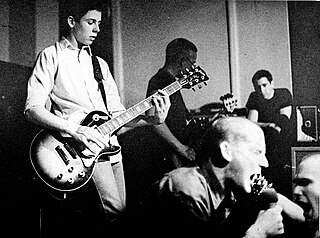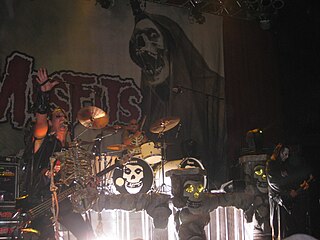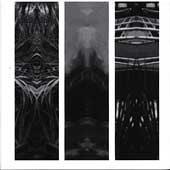Punk rock is a music genre that emerged in the mid-1970s. Rooted in 1950s rock and roll and 1960s garage rock, punk bands rejected the corporate nature of mainstream 1970s rock music. They typically produced short, fast-paced songs with hard-edged melodies and singing styles with stripped-down instrumentation. Lyricism in punk typically revolves around anti-establishment and anti-authoritarian themes. Punk embraces a DIY ethic; many bands self-produce recordings and distribute them through independent labels.
Rock is a broad genre of popular music that originated as "rock and roll" in the United States in the late 1940s and early 1950s, developing into a range of different styles from the mid-1960s, particularly in the United States and the United Kingdom. It has its roots in 1940s and 1950s rock and roll, a style that drew directly from the genres of blues, rhythm and blues, and from country music. Rock also drew strongly from genres such as electric blues and folk, and incorporated influences from jazz and other musical styles. For instrumentation, rock has centered on the electric guitar, usually as part of a rock group with electric bass guitar, drums, and one or more singers. Usually, rock is song-based music with a 4
4 time signature using a verse–chorus form, but the genre has become extremely diverse. Like pop music, lyrics often stress romantic love but also address a wide variety of other themes that are frequently social or political. Rock was the most popular genre of music in the U.S. and much of the Western world from the 1950s to the 2010s.

Hardcore punk is a punk rock music genre and subculture that originated in the late 1970s. It is generally faster, harder, and more aggressive than other forms of punk rock. Its roots can be traced to earlier punk scenes in San Francisco and Southern California which arose as a reaction against the still predominant hippie cultural climate of the time. It was also inspired by Washington, D.C., and New York punk rock and early proto-punk. Hardcore punk generally disavows commercialism, the established music industry and "anything similar to the characteristics of mainstream rock" and often addresses social and political topics with "confrontational, politically charged lyrics".
Emo is a music genre characterized by emotional, often confessional lyrics. It emerged as a style of hardcore punk and post-hardcore from the mid-1980s Washington, D.C. hardcore scene, where it was known as emotional hardcore or emocore. The bands Rites of Spring and Embrace, among others, pioneered the genre. In the early-to-mid 1990s, emo was adopted and reinvented by alternative rock, indie rock, punk rock, and pop-punk bands, including Sunny Day Real Estate, Jawbreaker, Cap'n Jazz, and Jimmy Eat World. By the mid-1990s, Braid, the Promise Ring, and the Get Up Kids emerged from Midwest emo, and several independent record labels began to specialize in the genre. Meanwhile, screamo, a more aggressive style of emo using screamed vocals, also emerged, pioneered by the San Diego bands Heroin and Antioch Arrow. Screamo achieved mainstream success in the 2000s with bands like Hawthorne Heights, Silverstein, Story of the Year, Thursday, the Used, and Underoath.
Gothic rock is a style of rock music that emerged from post-punk in the United Kingdom in the late 1970s. The first post-punk bands which shifted toward dark music with gothic overtones include Siouxsie and the Banshees, Joy Division, Bauhaus, and the Cure.

The Misfits are an American punk rock band often recognized as the pioneers of the horror punk subgenre, blending punk and other musical influences with horror film themes and imagery. The group was founded in 1977 in Lodi, New Jersey, by vocalist, songwriter and keyboardist Glenn Danzig. Over the next six years, Danzig and bassist Jerry Only were the group's main members through numerous personnel changes. During this period, they released several EPs and singles, and with Only's brother Doyle as guitarist, the albums Walk Among Us (1982) and Earth A.D./Wolfs Blood (1983), both considered touchstones of the early-1980s hardcore punk movement. The band has gone through many lineup changes over the years, with bassist Jerry Only being the only constant member in the group.
Indie rock is a subgenre of rock music that originated in the United Kingdom, United States and New Zealand in the early to mid-1980s. Although the term was originally used to describe rock music released through independent record labels, by the 1990s it became more widely associated with the music such bands produced.

AFI is an American rock band from Ukiah, California, formed in 1991. Since 1998, it consists of lead vocalist Davey Havok, drummer and backing vocalist Adam Carson, bassist, backing vocalist and keyboardist Hunter Burgan, and guitarist, backing vocalist and keyboardist Jade Puget. Havok and Carson are the sole remaining original members. Originally a hardcore punk band, they have since delved into many genres, starting with horror punk and following through post-hardcore and emo into alternative rock and gothic rock.
Alternative rock is a category of rock music that evolved from the independent music underground of the 1970s. Alternative rock acts achieved mainstream success in the 1990s with the likes of the grunge, shoegaze, and Britpop subgenres in the United States and United Kingdom, respectively. During this period, many record labels were looking for "alternatives", as many corporate rock, hard rock, and glam metal acts from the 1980s were beginning to grow stale throughout the music industry. The emergence of Generation X as a cultural force in the 1990s also contributed greatly to the rise of alternative rock.
Pop-punk is a rock music fusion genre that combines elements of punk rock with power pop or pop. It is defined by its fast-paced, energetic tempos, and emphasis on classic pop songcraft, as well as adolescent and anti-suburbia themes. It is distinguished from other punk-variant genres by drawing more heavily from 1960s bands such as the Beatles, the Kinks, and the Beach Boys. The genre has evolved throughout its history, absorbing elements from new wave, college rock, ska, rap, emo, boy band pop and even hardcore punk. It is sometimes considered interchangeable with power pop and skate punk.
Skate punk is a skater subculture and punk rock subgenre that developed in the 1980s. Originally a form of hardcore punk that had been closely associated with skate culture, skate punk evolved into a more melodic genre of punk rock in the 1990s similar to pop punk. Since then, it has predominately featured fast tempos, lead guitar playing, fast drumming, and singing. Occasionally, skate punk also combines the fast tempos of hardcore punk and melodic hardcore with the catchy hooks of pop-punk.

Horror punk is a music genre that mixes punk rock and 1950s-influenced doo-wop and rockabilly sounds with morbid and violent imagery and lyrics which are often influenced by horror films and science fiction B-movies. The genre was pioneered by the Misfits in the late 1970s and early 1980s. Subsequent bands formed in the Misfits' wake like Mourning Noise, the Undead and Samhain, solidifying horror punk's first wave. In the late 1990s and early 2000s the genre gained attention through the reunion of the Misfits and success of groups like AFI, Son of Sam and the Murderdolls. This popularity continued to the modern day with Blitzkid, Calabrese and Creeper.

Crust punk is a subgenre of punk rock influenced by the English punk scene as well as extreme metal. The style, which evolved in the early 1980s in England, often has songs with dark and pessimistic lyrics that linger on political and social ills. The term "crust" was coined by Hellbastard on their 1986 Ripper Crust demo.
Roots rock is a genre of rock music that looks back to rock's origins in folk, blues and country music. It is seen as responses to the perceived excesses of the dominant psychedelic and the developing progressive rock. Because roots music (Americana) is often used to mean folk and world musical forms, roots rock is sometimes used in a broad sense to describe any rock music that incorporates elements of this music. In the 1980s, roots rock enjoyed a revival in response to trends in punk rock, new wave, and heavy metal music.

A Sectioned Beam is Lansing-Dreiden's follow up extended play (EP) to their debut album, The Incomplete Triangle. It was released by Kemado Records on November 16, 2004, and was reissued on vinyl by Kemado imprint Mexican Summer in 2013.
New wave in Yugoslavia was the new wave music scene of the Socialist Federal Republic of Yugoslavia. As its counterparts, the British and the American new wave, from which the main influences came, the Yugoslav scene was also closely related to punk rock, ska, reggae, 2 tone, power pop and mod revival. Some of its acts are also counted as belonging to the Yugoslav punk scene which already existed prior to new wave. Such artists were labeled as both punk rock and new wave.
Lansing-Dreiden is an American band and art collective based in New York City.
Punk jazz is a genre of music that combines elements of jazz, especially improvisation, with the instrumentation and performance style of punk rock. The term was first used to describe James Chance and the Contortions' 1979 album Buy. Punk jazz is closely related to free jazz, no wave, and loft jazz, and has since significantly inspired post-hardcore and alternative hip hop.
Post-punk is a broad genre of music that emerged in 1977 in the wake of punk rock. Post-punk musicians departed from punk's traditional elements and raw simplicity, instead adopting a broader, more experimental approach that encompassed a variety of avant-garde sensibilities and non-rock influences. Inspired by punk's energy and do it yourself ethic but determined to break from rock cliches, artists experimented with styles like funk, electronic music, jazz, and dance music; the production techniques of dub and disco; and ideas from art and politics, including critical theory, modernist art, cinema and literature. These communities produced independent record labels, visual art, multimedia performances and fanzines.






